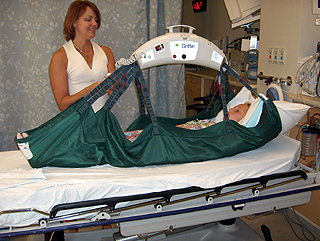
DJC.COM
November 16, 2006
New law encourages hospitals to give patients a lift
Clark/Kjos Architects

Couch
|
Anyone ending up in a health care environment will likely be subject to some kind of transport — from one bed to another, from a gurney to a stretcher, or even from a wheelchair to a bed.
Patients who are conscious, not in pain and are able will most likely move themselves from one bed to the other. However, in most cases, patients cannot move themselves and must rely on medical personnel. And almost to the person, medical staff tells us it’s not the heavier, bariatric patients who cause the greatest potential for injury to staff — it can be any patient regardless of size who needs to be transferred, stood up or lifted.
To address growing concerns over staff injuries and workers’ compensation claims, Washington state established a “safe patient handling committee” requirement with the passing of House Bill 1672 last March (Texas has a similar law, with California and New Jersey following).

Photo courtesy of Clark/Kjos Architects A state law set to go into effect next year will require hospitals eventually to install lift systems throughout the hospital to reduce staff injuries. The child here is positioned in a sling attached to a hanger that hooks to a hoist. |
By December of 2007 administrative staff and those working directly with patients are required to establish a program that addresses how the hospital will handle the lifting of patients. The second provision of HB 1672 is that by 2010 hospitals will be required to have one readily available lift per acute care unit, one lift for every 10 acute care inpatient beds, or equipment to be used by the lift team.
Architects have been installing patient lift systems in hospitals for decades. Their use began in physical therapy departments, therapeutic pools and in areas where patients had to be lifted in or onto medical equipment.
With the increase in bariatric patient populations, the focus has shifted from the occasional lift installation at specialized areas to install lift systems where staff needs them most — at patient beds, post-anesthesia care units, surgery rooms — any place where transfer is a major part of a patient’s routine of care.
Lift options
Patient-lifting can be handled in a variety of ways:
• One option is a patient transfer device, a freestanding lift that is usually kept in a room on a patient floor. Devices such as these will meet the requirement for HB 1672, and may be the most cost-effective means to facilitate patient transfers.
The downside of the freestanding device is that when needed, it can sometimes be difficult to locate if not dutifully returned to its assigned storage area. In addition, these tend to be large, unwieldy pieces of equipment, and it can be challenging maneuvering them in tight patient rooms.
• A second approach is to install full-lift systems in patient rooms. This allows staff quick, convenient lift access when needed, encouraging immediate use and saving time otherwise spent calling a lift team or locating a freestanding lift device.
Depending on the type of room, the layout can be as simple as a single track over the bed or comprehensive as full-room coverage, known as an XY gantry. Some facilities opt to provide track to toilet rooms as well.
Good Samaritan Regional Medical Center in Corvallis, Ore., provides single track and hoists in all new and remodeled patient rooms, and full-room coverage and hoists in all its new and remodeled critical care rooms.
• A third method is similar to a full-lift system. Track is installed in every room, but a single portable hoist is taken to patient rooms when needed. Providence St. Peter Hospital in Olympia uses this approach.
Transfer systems
A transfer system consists of three main components, no matter the manufacturer:
• Rails. Ceiling-mounted rails support the motor and are supported by anchoring devices attached to structure.
• Hoist. Also known as the hoistbox, or motor, hoists are designed to carry a variety of weight. Typical single hoists can carry weights from 300 to 550 pounds. In load needs of 1,000 pounds, two hoists are usually required. The hoist is usually controlled by either a remote device or a hand-held control that is attached directly.
• Hanger bar/sling. The sling is positioned under the patient, attached to the hangar then hooked to the hoist. Slings vary greatly by manufacturer, and can either be reused or disposable.
3 design tips
In both new and remodeled applications, track layout can be tricky. Here are some points to consider:
• The patient sling and hanger bars need to be parked at a location that is both out of the way and easy to grab. The hanger bar can be raised to ceiling height to get out of the way, but the control component must be within reach of staff to lower the device when needed. Some hospitals have designed custom holders for this apparatus, while some manufacturers provide wall-mounted brackets.
• The motors must have an electrical outlet in the ceiling near their parked location to charge the unit when not in use.
• Ceilings need to be at a height which allows the patient to be fully lifted off the bed. Nine feet is a recommended height, although 8-foot ceilings can be accommodated using recessed track.
Ceiling-installed items such as lights, mechanical diffusers, smoke detectors, fire sprinklers and cubicle curtain track need to be arranged to be out of the way of the rail. Some transverse rail systems have a space allowance of up to 1.5 inches, which will allow fire sprinklers to remain in place in retrofit applications.
Hospitals benefit
Keeping experienced medical staff on the job for many years is ultimately the goal of patient lift systems.
As Maureen Murphy, nurse department manager at Good Samaritan says, “Our current patient population expect their care to be delivered in a safe and efficient manner. The use of lift devices allows for this expectation to be achieved.
“As the bariatric patient population grows, lift devices will allow for the older nurses to continue to bring their years of knowledge to their patients’ bedside without fear of injury to themselves.”
Erin K. Couch is a project manager at Clark/Kjos Architects.
Other Stories:
- Hospital gardens help patients heal
- Hotels offer lessons for Oregon hospital
- State to adopt national health care design standards
- Quick! Turn an office building into a medical center
- Complex projects call for virtual construction
- Build a better building with 3-D modeling
- Boomers shaping future of health care design
Copyright ©2009 Seattle Daily Journal and DJC.COM.
Comments? Questions? Contact us.